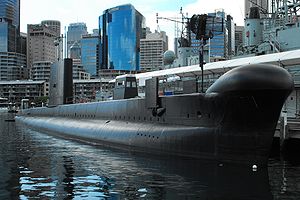HMAS Onslow

HMAS Onslow on display at the Australian National Maritime Museum
|
|
| History | |
|---|---|
|
|
|
| Namesake: | Town of Onslow, Western Australia |
| Ordered: | 1963 |
| Builder: | Scotts Shipbuilding and Engineering Company, Greenock |
| Laid down: | 4 December 1967 |
| Launched: | 3 December 1968 |
| Commissioned: | 22 December 1969 |
| Decommissioned: | 30 March 1999 |
| Refit: | Modernisation (1982–1984) |
| Homeport: | HMAS Platypus Sydney |
| Motto: | Festina Lente ("Hasten Slowly") |
| Status: | Museum ship at the Australian National Maritime Museum |
| General characteristics | |
| Class and type: | Oberon-class submarine |
| Displacement: |
|
| Length: | 295.2 ft (90.0 m) |
| Beam: | 26.5 ft (8.1 m) |
| Draught: | 18 ft (5.5 m) |
| Propulsion: |
|
| Speed: |
|
| Range: | 9,000 nautical miles (17,000 km; 10,000 mi) at 12 knots (22 km/h; 14 mph) |
| Test depth: | 200 metres (660 ft) |
| Complement: |
|
| Sensors and processing systems: |
|
| Armament: |
|
| Notes: | Taken from: |
HMAS Onslow (SS 60/SSG 60) was one of six Oberon-class submarines operated by the Royal Australian Navy (RAN). The submarine was named after the town of Onslow, Western Australia, and Sir Alexander Onslow, with the boat's motto and badge derived from Onslow's family heritage. Ordered in 1963, Onslow was laid down at the end of 1967 by Scotts Shipbuilding and Engineering Company in Scotland, launched almost a year later, and commissioned into the RAN at the end of 1968.
Although never involved in war, three major incidents occurred during Onslow's career. The first occurred in 1972, when a disgruntled sailor who disobeyed orders caused the submarine to dive to almost twice her safe operating depth. As a result, the RAN changed the Submarine Service from being able to "conscript" any sailor for submarine service to volunteer only. The second happened in 1981, when carbon monoxide fumes from one of the diesel generators filled the submarine, resulting in the death of one sailor. Although changes were made to submarine operating procedures, the boat's company was not provided with any psychological counselling, and the incident report remained classified until 2009. The third was a controversial line-crossing ceremony in 1995, which resulted in restrictions being placed on similar ceremonies aboard RAN vessels. During her career, Onslow became the first conventionally powered submarine to be fitted with anti-ship missiles, and was successful in wargames: "sinking" a seven-ship flotilla during Exercise Kangaroo 3 in 1980, and the United States supercarrier USS Carl Vinson at RIMPAC 1998.
Onslow was decommissioned in 1999, and was presented to the Australian National Maritime Museum, where she is preserved as a museum ship.
...
Wikipedia
